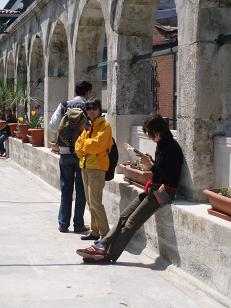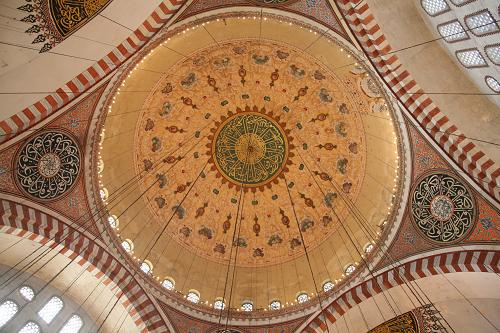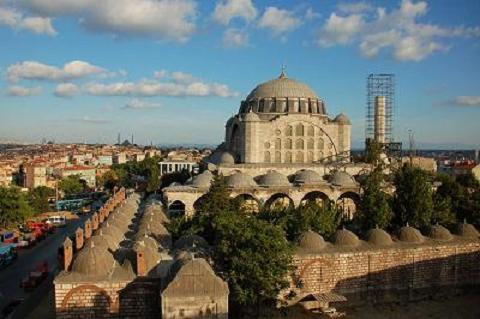
|
|




Excursion Route 1- From Besiktas to Üsküdar
Hüsrev Kethüda Bath House, Barbaros Hayrettin Paşa Tomb, Sinan Paşa Complex, Kılıç Ali Paşa Complex, Atik Valide Complex, Valide Sultan Bathhouse, Mihrimah Sultan Complex, Şemsi Paşa Complex
One of the most scenic of the routes to visit Sinans architectural works is perhaps from Besiktas to Üsküdar. The features that make this route delightful are its pedestrian experience and the spectacular view of the Bosphorus as you cross over to Üsküdar from the European side. On this excursion route you will be able to see one example of almost each type of building Sinan has designed.
Following breakfast at Ortaköy, your first stop will be the double bath house, which is also known as The Ortaköy Bath. Hüsrev Kethuda, who was a steward to Vizier Kara Ahmet Pasha, sponsored its construction. After functioning as a nightclub/restaurant for a number of years, this building has now been closed.. The plan and masonry still reflect its 16th century characteristics.
The next path is the road between Ortaköy and Besiktas, either on foot or by public transportation. Those who choose the pedestrian way will have a chance to visit the Tomb of Yahya Efendi. Built by Sinan, this structure has nevertheless lost its 16th century details; it can be reached following the narrow road up the hill, right before the entrance to Yıldız Park. Its walled-in cemetery area is quite large and rich in history.
We recommend taking a break and stopping by the seaside before visiting the tomb of Barbaros Hayrettin at Besiktas. This break will make it possible for you to take in the view of the Sinan buildings that you will visit in Üsküdar on the Asian side across the Bosphorus. The first stop following your rest will be the tomb of Barbaros Hayretin Pasha, the first grand admiral of the Ottoman Empire.
Across from the mausoleum, stands the Sinan Pasha Mosque, which was built for another grand admiral. For the mosques he built in the names of the Ottoman admirals, Sinan tended to chose plan types that recall archetypes of the early Ottoman architecture. The plan of the mosque within this Sinan Pasha Complex bears great resemblance to the older Üç Serefeli Mosque, built by the Ottoman Sultan Murat II, in Edirne.
Continue your walk towards a mosque that was built by Sinan in the name of another master mariner. Right before you come upon the mosque that Grand Admiral Kılıç Ali Pasha had constructed in his name, we recommend that you stop by the Molla Çelebi Mosque, which is a small-scale Sinan structure built during the years 1561-1562.
As you view the Kılıç Ali Pasha Mosque, you may be reminded of its similarity to the Hagia Sophia. When Sinan was designing this mosque, he may have referred to the architecture of the Hagia Sophia, which is a 6th century building that bears great significance in the history of world architecture. We know that Kılıç Ali Pasha was of Italian origin. As he headed to study in a religious school to become a priest, the boat he had boarded was taken over by the Ottomans. Fate caught up with the novice Giovanni Dionigi Galeni in a boat and made him a mariner of the highest order in the Ottoman Navy.
Today, of the buildings in this complex, only the mosque is open to public. The Tomb of Kılıç Ali Pasha, the madrasa, and the Bath House can be viewed from the exterior. As you leave this complex, you will see the Tophane-i Amire (Royal Foundary) building across the road. Even though this building, which is now used as the Mimar Sinan Fine Arts University Culture and Arts Center,, is not Sinans work in its totality, 16th century documents reveal that Sinans supervision was influential in its construction. It is open to visitors only during cultural activities there.
Those who may be tired by now can leave the Üsküdar part of this route to the next day. However, our recommendation for you will be to visit Sinans works in Üsküdar during a late afternoon.
At Üsküdar, you may board a minibus following the route towards Zeynepkamil (the original route may be temporarily altered due to Marmaray construction work) and make a stop by the Sokullu Mehmet Pasa Ilkögretim Okulu (Elementary School). Behind the school, you will find the Atik Valide Complex, built by Nurbanu Sultan. Only the mosque in this complex is open to visitors. Some of the other buildings, which were used as a prison and as a high school for religious studies in the past, have now been turned over to the Marmara University for their use.

A vıew of the Kılıc Alı Mosque
As you stroll down the road towards Üsküdar, you will see the double bath that was sponsored by Nurbanu Sultan and which now it serves the Mimar Sinan Bazaar. In spite of the fact that it has lost its original state because of damage done during the widening process of the road and the concrete additions on its façade facing the Municipality Building, it is very much worth visiting.
As evening approaches slowly and the sun prepares to leave Istanbul over the Historic Peninsula, the terrace-court of the Mihrimah Sultan Complex, extending towards the sea, presents itself as one of the best viewpoints to observe the sunset.
The last stop of our excursion will be the Şemsi Pasha Complex, which can also be seen from the court of the Mihrimah Sultan Complex. The complex includes mosque and madrasa buildings and the tomb of Şemsi Pasa. Popularly known as the Kuskonmaz Mosque, this complex stands by the seaside today, still enduring the waves of the Bosphorus. Here, Sinan has tried an unusual design scheme, planning this mosque and tomb within the same space. As you enter into this small-scale mosque, you can view the casket of Şemsi Pasha through the opening on the left.
Sınan Pasa Mosque
Your Besiktas-Üsküdar excursion will end next to this complex by the seaside,. For those who wish to top this thorough excursion with traditional Turkish cuisine, we recommend Kanaat Restaurant.
If after seeing all of these Bosphorus sites, if you wish to have a fine seafood dinner, you will find plenty of small fish restaurants along the seaside.
Mıhrımah Sultan complex 
| © 2006 Respect to Sinan. All rights reserved. | [Çekül Foundation] [Union of Historical Towns] |
